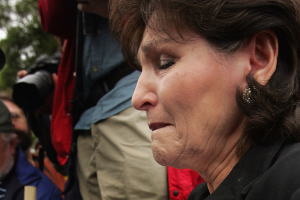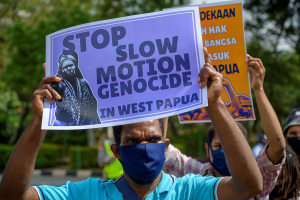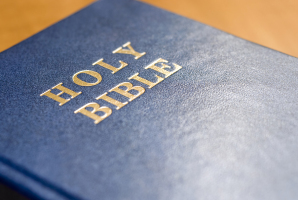Destroying Christian Cultural Heritage Sites: Don't Only Condemn ISIS, but Also These Globally Recognized Gov't

A recent video on the destruction of ancient monuments by Islamic State in the Middle East has shocked the international community. The ISIS has sought to justify destruction of Assyrian ancient monuments in Northern Iraq by Islamic norms. The International community's reaction was predictable: the United Nations' cultural agency labeled those actions as a war crime, calling the world to "respond to this criminal chaos that destroy culture" and "put an end to this catastrophe". Strong condemnation also came from global advocacy groups and academic circles that stressed that "ISIS' intent not only to control the future of humankind but also to erase and rewrite our past".
The destruction of cultural heritage is not a new phenomenon. Different historical sites and monuments were being hammered throughout the history of humankind. It is very disturbing that vandalism, coming from ancient times still continues to exist in the contemporary world. It is especially alarming when such tactics is used not only by radical groups, but also by states in order to re-write the past.
Terrorist group desecration is heinous enough, but what will the world community do when a recognized government does it?
In 2001, the Taliban detonated statues of Buddha in Bamiyan, central Afghanistan. The demolition was described as internal matter of Taliban-ruled Afghanistan and "justified" by the statues' contradiction to Islamic beliefs. The detonation was a culmination of cultural terrorism conducted by Taliban in Afghanistan to entirely eradicate Afghan cultural heritage.
Just as alarming is the high-level hatred towards Armenians by the Muslim government of Azerbaijan. Systematic destruction of Armenian monuments and Christian Armenian heritage in Azerbaijan culminated in December 2005, when the medieval Christian-Armenian cemetery in Nakhijevan's Julfa (Republic of Azerbaijan) was completely destroyed. Released video demonstrates how Azeri Army soldiers hammer down the millennia-old Armenian historical monuments – headstones, widely known as khachqars (or "crosstones" in Armenian). After destruction, Baku has turned the Armenian cemetery into a military shooting range, thus restricting access to the area. Two consecutive U.S. Ambassadors Matthew Bryza and Richard Morningstar made unsuccessful attempts to visit the cemetery. The government of Azerbaijan declined to allow their visit. European parliament's similar attempt was again blocked. However, Slavomir Horak, a scholar from Prague's Charles University, was able to visit the cemetery in 2009 and found no monuments left there.
Washington-based American Association for the Advancement of Science (AAAS) rented satellites, took high-res images of the site in 2009 and compared them with pictures that had been taken prior to the destruction. "As can be seen in the 2009 image, the appearance of additional dirt roads that traverse the cemetery and visibly smoother terrain suggest that the khachkars may have been destroyed or removed by earthmoving equipment," said Susan Wolfinbarger, senior program associate for the Geospatial Technologies and Human Rights Project, a part of the Science and Human Rights Program. "Our analysis of the satellite evidence is consistent with that of observers on the ground who have attested to the destruction of the khachkars and the leveling of the terrain in the Julfa cemetery."
Destruction of the Julfa cemetery is similar to the recent destruction of monuments by ISIS or earlier by Taliban. They all were instigated by a very high level of intolerance and hatred towards cultural heritage of another peoples and religions. Yet, there is a difference between those two, and that difference is the international status of perpetrators. If ISIS and the Taliban are isolated and marginalized radical groups, Azerbaijan presents itself as a recognized state and an equal member of the global community, which is expected to follow all the norms and rules of international law and civilized world. But it fails to do so. Besides, while ISIS and the Taliban did not even try to conceal their actions, Azerbaijan continues to deny the crime in Julfa, and has completely closed access to the area.
Baku's vandalism derived from its hostility with Armenia and Nagorno Karabakh. However, nothing can justify such attitude. "There is absolutely no political or religious justification for the destruction of humanity's cultural heritage", says UNESCO's statement.
Meanwhile, unlike Azerbaijan, both Armenia and Nagorno Karabakh have preserved non-Armenian heritage, including mosques and Muslim cemeteries. Karabakh authorities not only preserved, but also partially repaired several war-damaged Muslim mosques, particularly one in Shoushi. American scholar Wayne Merry, who traveled to Karabakh in 2011, later testified that he saw untouched Muslim cemeteries there. Meanwhile, the Armenian cemetery in Baku, capital of Azerbaijan, has been reportedly destroyed. The Armenian Church in Baku, although renovated, now serves as the archive department of the Department of Administration Affairs of the Presidential Administration of Azerbaijan.
Turning a blind eye, half-steps or lack of action against perpetrators creates dangerous perception that hammers and bulldozers represent useful instruments to achieve political goals and redesign history.




























